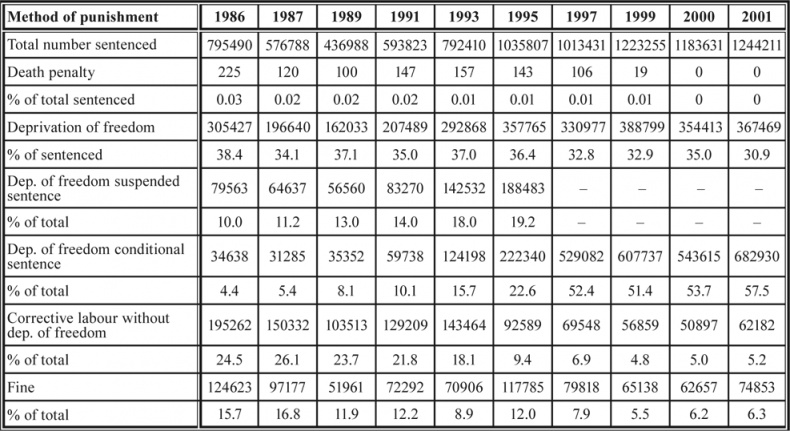There is a moratorium of the death penalty from 1997, but the Russian Parliament («Duma») does not ratify this.
We see tendency toward cutting down the severity of punishment without the deprivation of freedom in the penal and sentencing practice (table 9) – the quota of corrective labor without deprivation of freedom has decreased (from 26.4 % in 1988 to 5.2 % in 2001) while the quota of fine has decreased (from 16.8 % in 1987 to 6.3 % in 2001).
Table 9. Punishment in Russia (1986-2001)

Source: Crime and Delinquency. Statistical Review. Annual. Moscow: MVD RF, MJ RF.
Prison
There are 750 penitentiary institutions (labour settlements), 61 pedagogical colonies (for juvenile offenders), 13 prisons, and 174 jails in 1997 (Zubkov, Kalinin, Sysoev, 1998: 81).
The imprisonment rate per 100,000 population (Table 10) in Russia is the highest in the world (more than 720-730 in 1999, excluding institutions of military justice (Abramkin, 1998; Barclay, Tavares, 2003; Christie, 2000; Conditions of convicts in contemporary Russia, 2003; Walmsley, 2003). One in four adult men in Russia is a former prisoner. The overwhelming portion of the prisoners are not professional criminals, but people who found themselves in prison because they had been in a position of misery, unemployment, and homeless. The conditions in penitentiary institutions are terrible (Abramkin, 1998; Gilinskiy, 1998). Extremely harsh regimes in institutions leading to the deprivation of freedom suffered by those awaiting trial or under conditional sentence, contravene human rights, such as overcrowding in the pre-trial detention centers; compelling inmates to sleep in shifts; bad food; the spread of tuberculosis; torture of those awaiting trial, and under investigation in the «press cells»
[506] to procure confessions of guilt; and mass beatings. Life in institution for the deprivation of freedom (prisons and correctional colonies) is unbearable, and the possibilities for «correction» are nil. The correctional outcome is quite the reverse.
Thousands of prisoners die every year from hunger, tuberculosis, and suffocating from the lack of oxygen in overcrowded cells in pre-trial detention centers. More than 2,300 people wich HIV infections, and more than 92 thousands people with tuberculosis were in Russian penitentiary institutions in 1999 The situation in penitentiary institutions has slowly improved after the transfer from the Ministry of Internal Affairs to the Ministry of Justice.
Table 10. Prison population in Russia (1989-2001)

Source: Barklay G. & Tavares C, 2003: 22
Conclusion
Certainly, contemporary Russian system of the criminal justice and the police are more democratic and more liberal than in Soviet Union. But there are many negative manifestation and tendencies, particularly from 1999-2000. The number and rate of violence is very high, wich is a result of the poor social and economic situation, social and economic inequality, and mass exclusion from the economic system. There are the new waves of organized crime – aspiration to the legalization of criminal activity; transition to legal and semi-legal activity; infiltration to legal business and power structure; the politicization of organized crime; and the criminalization of policy and economy. Russia is going farther and farther along the road to being a criminal state and a criminalized society.
Corruption in contemporary Russia is a product of the political system – a mechanism of the political regime. Wholesale corruption is the most serious Russian problem, because all other Russian problems cannot be solved until the «black market» is eliminated. The criminal justice system is ineffective, fraught with injustice and corruption, and depends of corrupt policy and politicians. Finally, the police and other «powerful structure», including the FSB, are very repressive, undemocratic, and irresponsible.
References
Abadinsky, H. (1994). Organized Crime. Fourth Edition. Chicago: Nelson-Hall.
Abramkin, V. (1998). In Search of a Solution. Crime, Criminal Policy and Prison Facilities in the Former Soviet Union. Second Edition. Moscow: Human Rights Publishers.
Albanese, J. (2000) The Mafia Mystique: Organized Crime. In: Criminology. A Contemporary Handbook. Third Edition. Ed. by J. Sheley Wadsworth Publishing Company. Pp. 265-286.
Arlacchi, P. (1986). Mafia Business. The Mafia Ethic and the Spirit of Capitalism. Verso Edition.
Barclay, G. and Tavares, С (2003). International comparisons of criminal justice statistics 2001 Home Office Statistical Bulletin. London. Issue 12/03.
Berger, P., and Luckmann, T. (1967) The Social Construction of Reality. N.Y.: Doubleday
Christie, N. (1981) Limits to Pain. Oxford: Martin Robertson.
Christie, N. (2000) Crime Control as Industry: Towards Gulags, Western Style. Third Edition. Routledge.
Cohen, S. (1973) Folk Devils and Moral Panics. St. Albans, Paladin.
Conditions of convicts in contemporary Russia (2003). Moscow: Moscow's Helsinki's Groups (Russian).
Consedine, J. (1995) Restorative Justice: Healing the Effects of Crime. Ploughshares Publications.
Corruption and Combat Corruption (2000). Moscow: Institute of General Prosecutor's Office.
Crime and Delinquency. Statistical Review. Annual. Moscow: MVD RF, MJ RF (in Russian).
Davis, N, Anderson, B. (1983/ Social Control: The Production of Deviance in the Modern State. Irvington Publishers, Inc.
Everyone's Newspaper, 1995, N 51.
Finer, C. and Nellis, M. (Eds.) (1998). Crime and Social Exclusion. Black-well Publishers, Ltd.
Gavrilov, B. (2001) Can Russian Statistics on Crime become Realistic? // Government and Law. N 1, pp. 47-62 (Russian).




